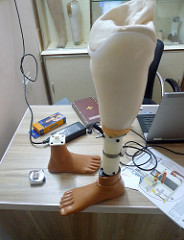Prosthetic body parts are by no means a new concept; the earliest functioning prosthetic recorded is a big toe that dates back to as early as 664 BC. However, as technology rapidly advances in today’s modern society, prosthetics have evolved quite a bit from their original rudimentary designs, enabling patients to have a greater quality of life.
Let’s take a look at some of the many advances that scientists have made in this new age of prosthetics:
Sensory Feedback – Giving Patients a Sense of Touch
As prosthetic technology continues to develop, scientists have now targeted a new facet of prosthetics: allowing users to regain their sense of touch. One current technology being used is sensory substitution, which replaces one sensory input with another. New prosthetic technologies use tactile sensors to give the sensation of feeling. Tactile sensors are devices that collect data on the interaction between prosthetic and physical surfaces. When tactile sensors are stimulated, part of the prosthetic applies vibrations to the patient’s skin. Another technology currently utilized is direct neural stimulation. In direct neural stimulation, electrodes are placed near or on the nerves and are stimulated by tactile sensors attached to the prosthetics. Direct neural stimulation is a slight step up from sensory substitution in that it provides a sense of touch through neural stimulation as opposed to simply applying vibrations to the patient’s skin.
Image Source: cliquephoto
Another example of prosthetic technology that provides sensory feedback is targeted muscle reinnervation (TMR). TMR surgically reassigns and transfers nerves to intact muscles and overlying skin to restore the patients’ ability to feel again. One new technology currently being developed by scientists at the University of Michigan is a regenerative peripheral nerve interface (RPNI). The RPNI is implanted into the patient’s residual limb, where skeletal muscle grafts are connected to the nerves that once controlled the missing limb. A conductive polymer is then wrapped around the RPNI, where it acts as an electrode and stimulates the RPNI. This allows for patients to feel again, and can allow for sensory feedback in prosthetics. All of the aforementioned technologies are utilized to allow patients with prosthetics to regain their sense of touch in their missing limbs.
Mind Control
Johns Hopkins University has pioneered a new type of prosthetic known as Modular Prosthetic Limbs (MPL). With MPL, patients can control the prosthetic just by thinking about the movements they want to make. Patients must first undergo nerve remapping surgery before being fitted with the robotic prosthetic so that brain signals can be sent to the prosthetic. The prosthetic itself has 26 joints and can curl up to 45 pounds. Although it’s not available on the market yet and likely won’t be for a while, it definitely holds a lot of hope for the future!
Though these aforementioned advances in prosthetic technology already sound like things of the future, as scientists continue to make advances in technology and science, even more advanced and more innovative prosthetics continue to be built. Perhaps in the future, real arms and prosthetic arms may seem almost indistinguishable to patients.
Feature Image Source: With Jaipur foot, ankle block sort of high by Nadya Peek










